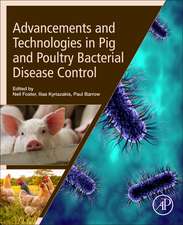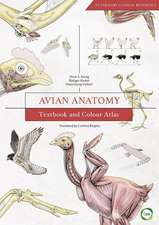Smart Livestock Nutrition: Smart Animal Production, cartea 2
Editat de Ilias Kyriazakisen Limba Engleză Hardback – 20 apr 2023
The first chapters focus on advances in biological fields such as molecular agriculture and genotype selection, as well as technologies that enhance or enable the collection of relevant information. The next section highlights applications of smart nutrition in a variety of livestock systems, ranging from intensive indoor housing of broilers and pigs to extensive outdoor housing of cattle and sheep, and marine fish farms. Finally, because of the worldwide attention to this issue, the authors address the environmental consequences.
This work, which takes a serious look at how nutrition can be usedto improve sustainability in animal agriculture, is a key literature for readers in animal and veterinary sciences, the food industry, sustainability research, and agricultural engineering.
Preț: 1293.22 lei
Preț vechi: 1361.28 lei
-5% Nou
Puncte Express: 1940
Preț estimativ în valută:
247.45€ • 259.06$ • 204.75£
247.45€ • 259.06$ • 204.75£
Carte tipărită la comandă
Livrare economică 05-19 aprilie
Preluare comenzi: 021 569.72.76
Specificații
ISBN-13: 9783031225833
ISBN-10: 303122583X
Pagini: 336
Ilustrații: VIII, 336 p. 1 illus.
Dimensiuni: 155 x 235 mm
Greutate: 0.66 kg
Ediția:1st ed. 2023
Editura: Springer International Publishing
Colecția Springer
Seria Smart Animal Production
Locul publicării:Cham, Switzerland
ISBN-10: 303122583X
Pagini: 336
Ilustrații: VIII, 336 p. 1 illus.
Dimensiuni: 155 x 235 mm
Greutate: 0.66 kg
Ediția:1st ed. 2023
Editura: Springer International Publishing
Colecția Springer
Seria Smart Animal Production
Locul publicării:Cham, Switzerland
Cuprins
Chapter 1. Putting Smart into Nutrition.- Chapter 2. Mozatching Feed Characteristics to Animal Requirements Through Plant Breeding.- Chapter 3. Circular Feed Production and Consumption in The Context Of Smart Animal Nutrition.- Chapter 4. Assessment of The Nutritive Value of Individual Feeds and Diets by Novel Technologies.- Chapter 5. Large Scale Phenotyping and Genotyping: State of The Art and Emerging Challenges.- Chapter 6. Mathematical and Statistical Approaches to The Challenge of Forecasting Animal Performance for The Purposes of Precision Livestock Feeding.- Chapter 7. Smart Pig Nutrition in the Digital Era.- Chapter 8. Smart Poultry Nutrition.- Chapter 9. Advanced Technology in Aquaculture – Smart Feeding in Marine Fish Farms.- 10. Smart Nutrition of Extensively Kept Ruminants.- Chapter 11. The Potential Contribution of Smart Animal Nutrition in Reducing The Environmental Impacts of Livestock Systems.
Notă biografică
Ilias Kyriazakis is Professor of Animal and Veterinary Science at Queen’s University, Belfast. The overall theme of his work is on the development and application of novel management strategies that aim to enhance the sustainability of livestock systems. His particular focus is on the effects of animal nutrition on the ability of animals to cope with pathogens and the reduction of the environmental impact of their systems. To this effect, he is using smart technologies, data analytics and simulation approaches to quantify or predict what will happen if a particular animal is fed in particular way whilst kept in a particular environment.
Textul de pe ultima copertă
This book highlights the latest findings and techniques related to nutrition and feed efficiency in animal agriculture. It addresses the key challenges facing the nutrition industry to achieve high animal productivity with minimal environmental impact. The concept of smart nutrition involves the use of smart technologies in the feeding and management of livestock.
The first chapters focus on advances in biological fields such as molecular agriculture and genotype selection, as well as technologies that enhance or enable the collection of relevant information. The next section highlights applications of smart nutrition in a variety of livestock systems, ranging from intensive indoor housing of broilers and pigs to extensive outdoor housing of cattle and sheep, and marine fish farms. Finally, because of the worldwide attention to this issue, the authors address the environmental consequences.
This work, which takes a serious look at how nutrition can be used to improvesustainability in animal agriculture, is a key literature for readers in animal and veterinary sciences, the food industry, sustainability research, and agricultural engineering.
This work, which takes a serious look at how nutrition can be used to improvesustainability in animal agriculture, is a key literature for readers in animal and veterinary sciences, the food industry, sustainability research, and agricultural engineering.
Caracteristici
Up-to-date information on feeding livestock in view of recent technological advances Combines both theoretical (modelling) aspects and practical applications A synthesis of biological principles with technological details







